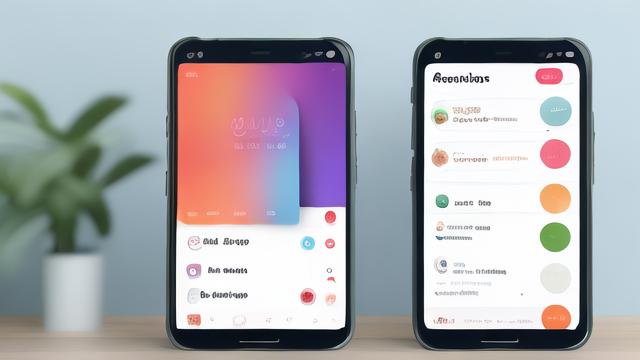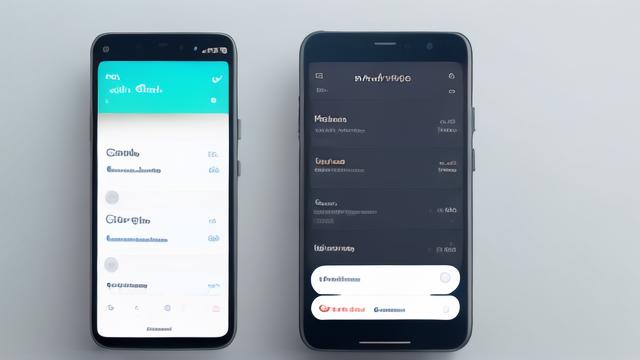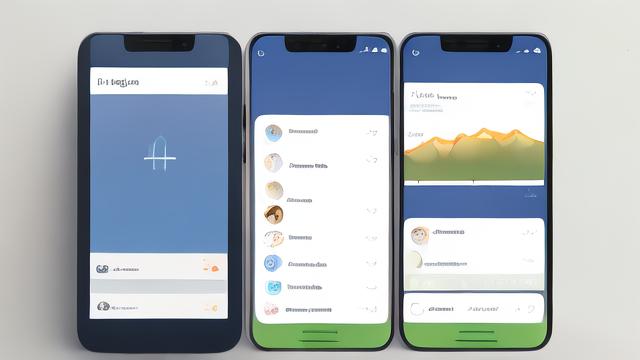在Android应用开发中,实现底部菜单和顶部导航是一种常见的设计模式,底部菜单通常用于提供快速访问主要功能或视图的入口,而顶部导航则用于展示应用的品牌标识、标题或其他重要信息,以下是关于如何在Android中实现这两种导航组件的详细步骤和小标题说明:

一、创建底部菜单(Bottom Navigation)
1. 添加依赖
确保在你的build.gradle文件中添加了必要的依赖项:
dependencies {
implementation 'com.google.android.material:material:1.4.0'
}2. 定义菜单资源
在res/menu目录下创建一个名为bottom_nav_menu.xml的文件,并定义底部菜单的结构:
<menu xmlns:android="http://schemas.android.com/apk/res/android">
<item
android:id="@+id/navigation_home"
android:icon="@drawable/ic_home"
android:title="Home" />
<item
android:id="@+id/navigation_dashboard"
android:icon="@drawable/ic_dashboard"
android:title="Dashboard" />
<item
android:id="@+id/navigation_notifications"
android:icon="@drawable/ic_notifications"
android:title="Notifications" />
</menu>3. 布局文件
在你的主布局文件(例如activity_main.xml)中添加BottomNavigationView:

<RelativeLayout xmlns:android="http://schemas.android.com/apk/res/android"
xmlns:tools="http://schemas.android.com/tools"
android:layout_width="match_parent"
android:layout_height="match_parent"
tools:context=".MainActivity">
<FrameLayout
android:id="@+id/container"
android:layout_width="match_parent"
android:layout_height="match_parent"
android:layout_above="@id/navigation" />
<com.google.android.material.bottomnavigation.BottomNavigationView
android:id="@+id/navigation"
android:layout_width="match_parent"
android:layout_height="wrap_content"
android:layout_alignParentBottom="true"
android:background="?android:attr/windowBackground"
app:menu="@menu/bottom_nav_menu" />
</RelativeLayout>4. 活动代码
在你的主活动(例如MainActivity.java)中设置BottomNavigationView的行为:
public class MainActivity extends AppCompatActivity {
private BottomNavigationView navigation;
private FrameLayout container;
@Override
protected void onCreate(Bundle savedInstanceState) {
super.onCreate(savedInstanceState);
setContentView(R.layout.activity_main);
navigation = findViewById(R.id.navigation);
container = findViewById(R.id.container);
navigation.setOnNavigationItemSelectedListener(new BottomNavigationView.OnNavigationItemSelectedListener() {
@Override
public boolean onNavigationItemSelected(@NonNull MenuItem item) {
switch (item.getItemId()) {
case R.id.navigation_home:
loadFragment(new HomeFragment());
return true;
case R.id.navigation_dashboard:
loadFragment(new DashboardFragment());
return true;
case R.id.navigation_notifications:
loadFragment(new NotificationsFragment());
return true;
}
return false;
}
});
}
private void loadFragment(Fragment fragment) {
// 切换到新的Fragment
FragmentTransaction transaction = getSupportFragmentManager().beginTransaction();
transaction.replace(R.id.container, fragment);
transaction.addToBackStack(null);
transaction.commit();
}
}二、创建顶部导航(Top App Bar)
1. 添加依赖
如果你还没有添加Material Components库,请参考底部菜单的步骤1。
2. 定义菜单资源
在res/menu目录下创建一个名为top_app_bar_menu.xml的文件,并定义顶部导航菜单的结构:

<menu xmlns:android="http://schemas.android.com/apk/res/android">
<item
android:id="@+id/action_settings"
android:icon="@drawable/ic_settings"
android:title="Settings" />
</menu>3. 布局文件
在你的主布局文件(例如activity_main.xml)中添加Toolbar作为顶部导航:
<RelativeLayout xmlns:android="http://schemas.android.com/apk/res/android"
xmlns:tools="http://schemas.android.com/tools"
android:layout_width="match_parent"
android:layout_height="match_parent"
tools:context=".MainActivity">
<androidx.appcompat.widget.Toolbar
android:id="@+id/toolbar"
android:layout_width="match_parent"
android:layout_height="?attr/actionBarSize"
android:background="?attr/colorPrimary"
android:popupTheme="@style/ThemeOverlay.AppCompat.Light"
app:titleTextColor="@android:color/white" />
<!-...其他布局... -->
</RelativeLayout>4. 活动代码
在你的主活动(例如MainActivity.java)中设置Toolbar的行为:
public class MainActivity extends AppCompatActivity {
private Toolbar toolbar;
@Override
protected void onCreate(Bundle savedInstanceState) {
super.onCreate(savedInstanceState);
setContentView(R.layout.activity_main);
toolbar = findViewById(R.id.toolbar);
setSupportActionBar(toolbar);
}
@Override
public boolean onCreateOptionsMenu(Menu menu) {
// Inflate the menu; this adds items to the action bar if it is present.
getMenuInflater().inflate(R.menu.top_app_bar_menu, menu);
return true;
}
@Override
public boolean onOptionsItemSelected(MenuItem item) {
// Handle action bar item clicks here. The action bar will
// automatically handle clicks on the Home/Up button, so long
// as you specify a parent activity in AndroidManifest.xml.
int id = item.getItemId();
//noinspection SimplifiableIfStatement
if (id == R.id.action_settings) {
return true;
}
return super.onOptionsItemSelected(item);
}
}是一个简单的例子,展示了如何在Android应用中实现底部菜单和顶部导航,你可以根据需要自定义菜单项和布局,以及添加更多的交互逻辑来满足你的应用需求。
以上内容就是解答有关“Android实现底部菜单和顶部导航”的详细内容了,我相信这篇文章可以为您解决一些疑惑,有任何问题欢迎留言反馈,谢谢阅读。